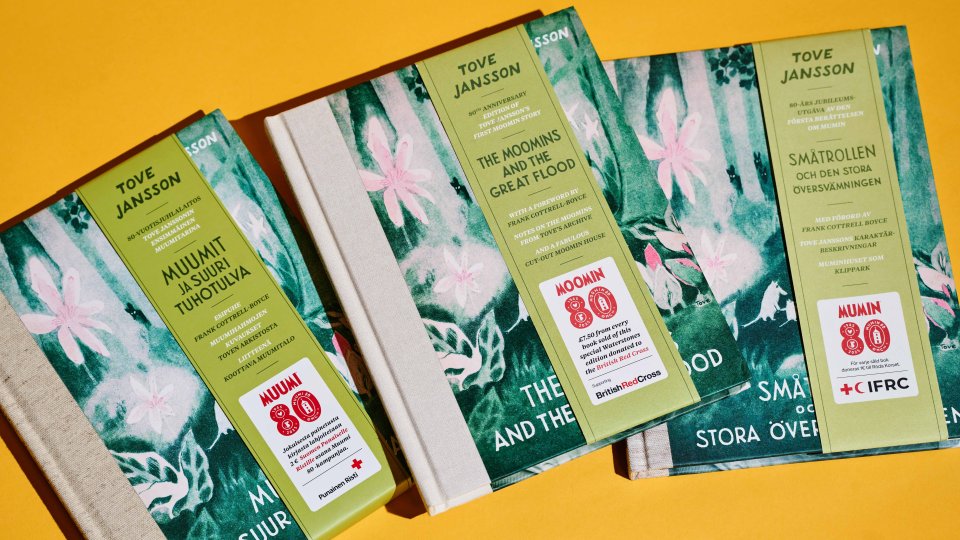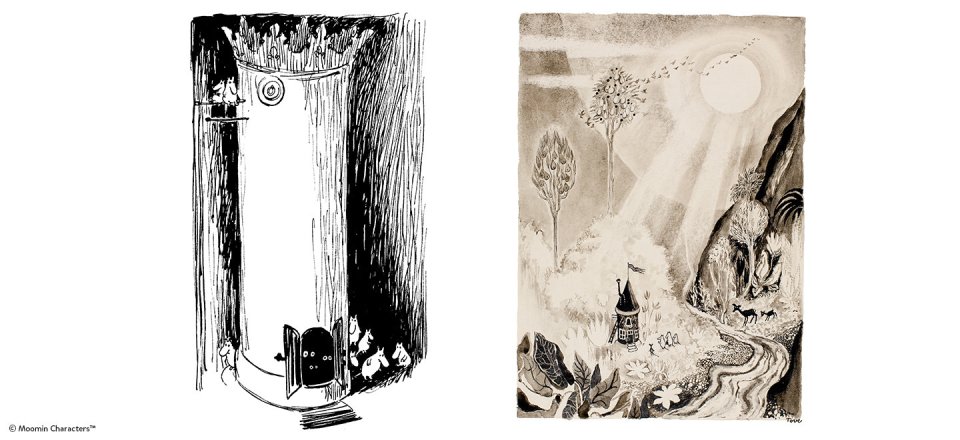How much did the war influence Tove Jansson’s first Moomin story? And what can it teach us about the importance of a proper handbag or that family doesn’t necessarily mean blood relatives? This blog presents a video about The Moomins and the Great Flood (1945) and answers these questions, amongst other heartfelt thoughts about the very first Moomin story.
In this video, Tove Jansson’s niece Sophia Jansson reads passages from the book and Boel Westin, researcher and expert on Jansson’s life and art, opens up the context of the story.
A story about hope
“Tove Jansson wrote the story during the winter war in the 1940s. There’s homelessness and the threat of annihilation. The catastrophe, the great flood, and the refugees show how Tove was influenced by the war. But then there is a happy ending – it’s a children’s book after all”, says professor Boel Westin, one of the most prominent experts on the Moomins and Tove Jansson, whom she’s written a biography about.
Jansson wrote in her diary that she dreamt of creating a happy society – another world – something different from the depressing and scary reality of World War II.
“And perhaps you can say that the Moomin world is a realisation of this dream”, Westin says.
Catastrophe as a theme is present already in the first Moomin story – a big flood is threatening the existence of the Moomintrolls, and the characters are portrayed as very small in comparison to the forces of nature.
“Catastrophe as a theme became important to Tove Jansson in many following books. Here it’s the great flood, later it’s the comet, or a volcano. That is a narrative concept that she often built her stories around”, Westin says.
For Tove Jansson the respect towards natural forces was often mixed with a fascination and attraction to storms and other dangerous phenomena. It was something she carried with her from childhood, a heritage from her father, the sculptor Viktor Jansson. She describes that feeling in her adult books too: for example, in the short story High Water in the self-biography The Sculptor’s daughter. There, a heavy storm is precisely what is needed to wake up a melancholic family father from the broodiness that is affecting the whole family – “The best storm we’ve ever had”, as the narrator expresses it.

Family – one of the most important themes
In the beginning of The Moomins and the Great Flood, Moomintroll and his mother are looking for a new home and searching for Moominpappa, who is missing. During the adventure, they meet various figures who either help them or are in need of help themselves. The Moomin family takes on these new acquaintances with open arms.
“In the beginning, there’s only a mother and her son. Then they meet a small animal, Sniff, who becomes a part of the family. It’s typical in the Moomin stories: family is a very flexible concept,” says Westin, implying that the idea of an extended family might be one of the most important themes present in the book.
“In the later Moomin books, when discussing guests who want to move in, there’s talk of only needing to build new beds and expand the dining table. I think that is a very Moominous concept.”

“The foundation for the Moomin world”
The Moomins and the Great Flood gives the reader insight into the lore of Moomintrolls, such as the fact that they used to live in symbiosis with humans behind their tile stoves – but that was before radiators. This little piece of history can be seen in the Moomins’ fascination with living in tower-like buildings.
In the first story, you also find out how the Moomin family makes their way to Moominvalley and what important part Moominmamma’s handbag, along with its contents, plays in the venture. Despite this book laying the foundation for the later Moomin books, it isn’t seen as part of the actual Moomin-canon, because it differs so much from the eight novels published after it, both regarding character depiction and narration.
“It’s a story written in a fairytale mode. It has lots of references to children’s classics. She hasn’t really developed her literary language yet. But at the same time, it’s a charming story. When you know there are more books to come, you can read this to get keys to events that will follow later. So it’s quite an important book, although it’s not the best book. But I think it’s sort of the foundation for the Moomin world”, Westin says.
Celebrating 80 years of Moomin stories
2025 marks the 80th anniversary of the Moomin stories. The central theme of the anniversary year is the Moominhouse and what it stands for – a sense of belonging, a place where the door is always open.
Today, when millions of people around the world are lacking care and security, Moomin Characters has teamed up with its longstanding partner The Red Cross to gather funds for those in need. A part of the proceeds from selected Moomin 80 products will be donated to the work of The International Federation of Red Cross and Red Crescent Societies (IFRC) through National Red Cross societies.

This applies also to the special anniversary editions of The Moomins and the Great Flood, available in English, Finnish and Swedish. These editions contain a brand new foreword by author Frank Cottrell-Boyce as well as never-before-published character descriptions written by Tove Jansson herself. The edition also features a full-colour cut-out Moomin house poster designed by Tove Jansson in the 1950s.

The Moomins and the Great Flood: The forgotten first story about the Moomins
“The Moomins and the Great Flood” is the first published Moomin story, often seen as a prelude to the eight Moomin novels by Tove Jansson.

The touching story behind Who Will Comfort Toffle
Did you know that Tove Jansson’s iconic picture book Who Will Comfort Toffle was inspired by a letter from a young reader? The backstory:

The first Moomin picture book was a praised breakthrough – how did Tove Jansson do it?
Curious about the first Moomin picture book? Watch our short documentary about the Book about Moomin, Mymble and Little My.
